"One and Indivisible" (A Russian Kaiserreich AAR)
- Thread starter Teivel
- Start date
-
We have updated our Community Code of Conduct. Please read through the new rules for the forum that are an integral part of Paradox Interactive’s User Agreement.
You are using an out of date browser. It may not display this or other websites correctly.
You should upgrade or use an alternative browser.
You should upgrade or use an alternative browser.
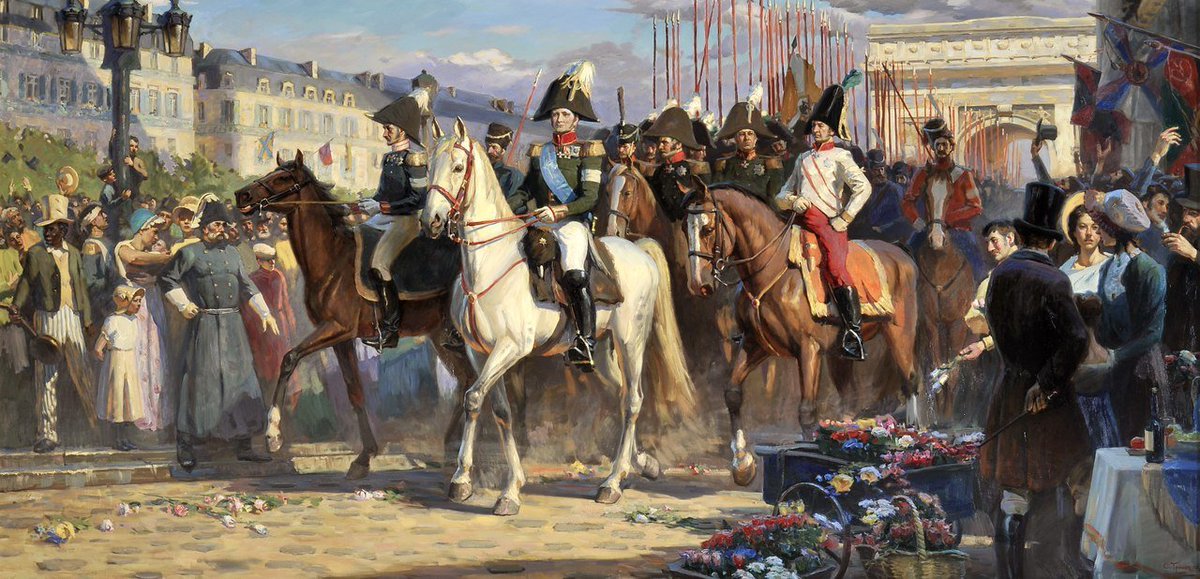
Tsar Alexander entering Paris in 1814 in style. Let's hope it takes less than two years of brutal warfare this time around!
- 1
My oh my, no fabricated pretext for the invasion? No fake attacks staged on radio stations? No alleged torpedo attacks on Russian ships? No direct and imminent justification to be cited to the Russian people? He's really daring...
If this invasion fails, the czar won't have to wait for the French to hang him, his own Russians will hang him! He would be the face of folly and hubris, forever!
Good luck
If this invasion fails, the czar won't have to wait for the French to hang him, his own Russians will hang him! He would be the face of folly and hubris, forever!
Good luck
Well, from the Russian point of view they have been attacked by the Commune when it engineered the assassination of the late Tsar.My oh my, no fabricated pretext for the invasion? No fake attacks staged on radio stations? No alleged torpedo attacks on Russian ships? No direct and imminent justification to be cited to the Russian people? He's really daring...
If this invasion fails, the czar won't have to wait for the French to hang him, his own Russians will hang him! He would be the face of folly and hubris, forever!
Good luck
This is just a delayed declaration of war
- 1
I am sure the late Tsar would understand and forgive the delay, there were some good reasons behind it:Well, from the Russian point of view they have been attacked by the Commune when it engineered the assassination of the late Tsar.
This is just a delayed declaration of war

My oh my, no fabricated pretext for the invasion? No fake attacks staged on radio stations? No alleged torpedo attacks on Russian ships? No direct and imminent justification to be cited to the Russian people? He's really daring...
If this invasion fails, the czar won't have to wait for the French to hang him, his own Russians will hang him! He would be the face of folly and hubris, forever!
Good luck
I'll write the speech and declaration at some point, obviously those won't go out before hostilities begin, don't want to give the Reds warning. But yes, no Gleiwitz incident, no dodgy torpedo attack claims, nothing that might be latched onto by opposition media as obviously fake. Just an assertion of of a threat (and previous crimes) and the need to strike now before they strike us.
Vladimir is too Canadian, and the media too fragmented, for any Polish radio station funny business.
Does that mean he'll be wearing it if it all goes wrong? Probably. Hopefully I conveyed just how aware of that he is. Is it enough to convince the Empire to throw itself against the reds? Yes, i'm not sure parts of the body politic really needed much prompting.
Last edited:
And one more for good measure, seeing as this is Vladimir III leading Russia into war, let's give him some musical support from across the multiverse:
Last edited:
The Fifth Era: The Great War
March 24, 1942 - ?
Vladimir III, Emperor and Autocrat of all the Russias and Emperor of the Romans

There will be no update tonight as I actually finally play out the first few days of Mercury and see if I've gotten rusty. So apologies but you'll have to settle for the title card.
March 24, 1942 - ?
Vladimir III, Emperor and Autocrat of all the Russias and Emperor of the Romans

There will be no update tonight as I actually finally play out the first few days of Mercury and see if I've gotten rusty. So apologies but you'll have to settle for the title card.
- 3
- 2
Those are some oddly German looking soldiers our forces are fighting. I'm sure they're conscripts from the puppet states.The Fifth Era: The Great War
March 24, 1942 - ?
Vladimir III, Emperor and Autocrat of all the Russias and Emperor of the Romans
View attachment 690233
There will be no update tonight as I actually finally play out the first few days of Mercury and see if I've gotten rusty. So apologies but you'll have to settle for the title card.
Well you read the French war plans didn't you?Those are some oddly German looking soldiers our forces are fighting. I'm sure they're conscripts from the puppet states.
Pretty bold of the German Syndie soldiers to stand up to so many tanks at such close range though
Death to the reds, may the armies of Holy Mother Russia be the instrument of God on earth to drive out the satanic forces of syndicalism from Europe.
TBH I think the reactionary forces have a pretty good shot. I dont think with the mobile forces unless the computer plays a very bad game or our boy gets very lucky he will be able to knock out France, but with the standing army of Austria, and the manpower of Russia e should be able to bleed the french to death in the western part of Germany
If I can be so bold, what is the current IC, production queues, and manpower look like for Russia?
Roughly 3.4 million manpower in the bank, which is a reflection of the focus on building a very mechanised, combined arms force rather than infantry spam.
Death to the reds, may the armies of Holy Mother Russia be the instrument of God on earth to drive out the satanic forces of syndicalism from Europe.
TBH I think the reactionary forces have a pretty good shot. I dont think with the mobile forces unless the computer plays a very bad game or our boy gets very lucky he will be able to knock out France, but with the standing army of Austria, and the manpower of Russia e should be able to bleed the french to death in the western part of Germany
If I can be so bold, what is the current IC, production queues, and manpower look like for Russia?
Industry has crested 700 (more once I can get my modifiers and dissent optimised again) to Americas 500 and something. Total Red IC is around 1600. Haven't counted Blufor IC but now Austria is in we're still behind but its closer than it was (we used to trail by 400-500). If I can collapse Germany and/or France we easily gain the IC edge, but then have ocean problems.
Production que is way too long to post but key inclusions include:
3 battleships
3 carriers
3 escort carriers
8 light cruisers
some destroyer lines
18 units of fighters
My first new marines
Self propelled artillery lines to cover the mobile units still missing them.
2 more transport plane units
2 more strat bombers
Bases and infrastructure to put down in conquered territory.
The number of new land divisions being raised isn't high, because upgrades are still sucking up lots of IC as I try and get all my cavalry up to the (amazing) mechanised cavalry standard.
In short, very very strong position. Even without gamey tactics, solid position for a player to work from. We're several hundred divisions behind the Reds, but all our divisions are where they need to be, theirs aren't. I think I can mince them in Germany at least.
- 2
- 1
Not to mention, as far as the Commune is concerned, its divisional total is often a mirage. I've often seen their divisions stay roughly the same but their actual army size go down from a deployed force of over a million to half a million in the course of several months of a protracted war with Germany due to attrition. In times my mobile offensive as the Commune of France failed, or even when it succeeds, it could take months to restore the manpower pool. It's their Achilles heel.Roughly 3.4 million manpower in the bank, which is a reflection of the focus on building a very mechanised, combined arms force rather than infantry spam.
Industry has crested 700 (more once I can get my modifiers and dissent optimised again) to Americas 500 and something. Total Red IC is around 1600. Haven't counted Blufor IC but now Austria is in we're still behind but its closer than it was (we used to trail by 400-500). If I can collapse Germany and/or France we easily gain the IC edge, but then have ocean problems.
Production que is way too long to post but key inclusions include:
3 battleships
3 carriers
3 escort carriers
8 light cruisers
some destroyer lines
18 units of fighters
My first new marines
Self propelled artillery lines to cover the mobile units still missing them.
2 more transport plane units
2 more strat bombers
Bases and infrastructure to put down in conquered territory.
The number of new land divisions being raised isn't high, because upgrades are still sucking up lots of IC as I try and get all my cavalry up to the (amazing) mechanised cavalry standard.
In short, very very strong position. Even without gamey tactics, solid position for a player to work from. We're several hundred divisions behind the Reds, but all our divisions are where they need to be, theirs aren't. I think I can mince them in Germany at least.
I'd like to try a game with an infantry army as the Commune sometime, though I dread to see the casualties.
- 1
Totally non-canon
.......
David Favre winced as he felt his forehead, where a lump was slowly forming. "What did you hit me with, a lead pipe?"
"No," replied Ivan, "It's rubber. It does have lead shot in the hollow itnerior. We thought it would be more convincing."
"So what now. The Swiss police will be after us."
"It'll take them a little time to get organised and spread the word on who they're looking for. So we dump the car and get into another," replied the driver, who'd introduced himself as Mischa. "Get some different clothes, drive out to Count Lichtenstein's country house, swap to a limo and drive in to the seaplane station. This time tomorrow you'll be in north Africa, on a train on the way to Cairo. Disguise and fake documents are ready for you."
It was the screech of the car brakes that drew the attention of the French delegation. As it mounted the pavement in the streets of Geneva, they scattered in pani trying to avoid becoming an accident statistic. Only... It didn't actually hit anyone. Instead, it screeched to a halt. Favre, their security liaison from the Intelligence services whose advice on Russian interests they'd been instructed to pay careful attention to, was scrambling to his feet feeling inside his jacket before anyone else could react. Then the rear doors to the car burst open and two armed men leapt out. As Favre drew his pistol, one of the men leapt forward and struck him over the head with a baton. Once, twice, three times. As Favre slumped to the floor the two men grabbed him and roughly dragged him into the car. By the time their other security could respond, it was driving off down the street, and the pistols that were all their guards had couldn't stop it before it turned a corner. Someone was going to have to tell Paris their intelligence specialist had been kidnapped off the street.Hopefully, our man in Paris will arrive in Switzerland quickly and safely.
.......
David Favre winced as he felt his forehead, where a lump was slowly forming. "What did you hit me with, a lead pipe?"
"No," replied Ivan, "It's rubber. It does have lead shot in the hollow itnerior. We thought it would be more convincing."
"So what now. The Swiss police will be after us."
"It'll take them a little time to get organised and spread the word on who they're looking for. So we dump the car and get into another," replied the driver, who'd introduced himself as Mischa. "Get some different clothes, drive out to Count Lichtenstein's country house, swap to a limo and drive in to the seaplane station. This time tomorrow you'll be in north Africa, on a train on the way to Cairo. Disguise and fake documents are ready for you."
- 1
- 1
Chapter 218: The Longest Day
Mercury: Day 1
“Soldiers of the Guard. In a few short hours you will jump into a hostile country. And not just any hostile country, you will jump into the viper’s nest, the heart of the Revolution, the Commune of France.Mercury: Day 1
You will secure your objectives, seizing bridges, forts, and railways. You will occupy the French fortifications and hold the way open until aid arrives, even if the entire Commune army crashes down on you.
You will do this because Europe must be made safe from the madness of revolution.
You will do this because it is the only way to protect the Holy Empire to which you belong.
You will do this because you are men of the Emperor’s Own Guard Regiment, and these bastards tried to kill your charge.
To your aircraft, Ura.”
-Guards Colonel Semenovski - I Guards Division (Emperor’s Own)
Operational Timeline: Mercury Day 1 (24 March)
Total Russian Day 1 Army Casualties (excluding allied forces): 6,580
00:00: Russian airborne forces are en route to their targets. By the time the primary attack opens, 138,000 men have been dropped behind enemy lines. 10 divisions seize a continuous line from Nurmberg to Chaumont, while the remaining two divisions are tasked to drop in the Prussian and North German rear areas to help facilitate their encirclement and the seizure of the infrastructure of state.
05:00: General offensive commences across the entire front. At critical points, Russian artillery concentrations rival that of the great war. The army tasked with defending the river crossing near Berlin is targeted by almost seven thousand guns and rocket projectors, including more than a thousand heavy pieces. There is approximately one Russian artillery piece for every three German defenders.
07:00: The Russian carrier fleet launches an attack on the regular Republican Navy North Sea Patrol force. The old battleship RNS Digger is sunk by B5Ns from Vladivostok along with a large number of escorts. The Russian carrier group runs for Copenhagen to avoid retribution by Republican aircraft and will remain there for the foreseeable future.
Russian bombers flying from Greece and the Levant launch a series of punishing attacks against the Republican Mediterranean fleet at Crete, sinking 3 second class battleships and an old battlecruiser, including RNS Leveller, Owen, Naseby, and Peterloo. This reduces Republican Naval Strength to its premier Carrier group, the Heavy Battleship fleet based in Florida, and the Home Fleet which has been defensively stationed on the West Coast of the Union of Britain.
08:00: Unescorted Russian bombers attempt to strike the British Home Fleet at anchor. Poor weather and Republican defences prevent any ships being sunk while twenty one aircraft are shot down. With the element of surprise lost, further raids on the British isles are suspended. Russian intelligence does not identify the role of radar in repelling the raid.
09:00: 3rd Shock Army reports the first confirmed breakthrough of the offensive, shattering the lone Prussian division holding the frontier north of the Berlin Sector.
11:00 X Guards (Armenian) Division is the only airborne unit reporting ongoing resistance in its immediate drop zone at Erfurt. German red units of the 5th Red Division fight on despite dissent in the ranks, but the shock of the Russian assault and the presence of glider-borne light tanks creates confusion in the German Ranks. Identifying the threat and determined to complete the encirclement of Prussia on schedule, Malinovski gives the Armenians priority for ground attack sorties. 900 strike sorties will be launched in support of the unit before the Germans relent.
12:00: Combined Russo-Hungarian forces report a breakthrough at Landshut against combined Franco-Bavarian defenders. The infantry begin their advance towards their objective of Munich.
13:00: Reports that the Bulgarian army is making ground in Dresden are overshadowed by the critical breakthrough of the 2nd Shock Army at Augsburg. The battle is technically the first tank battle of the war as the 2nd shock army unexpectedly encounters two brigades of medium tanks supporting the defenders. Twenty seven are knocked out for the loss of two Russian vehicles. Reports of ‘shot proof’ Russian vehicles are dismissed as panic mongering. The breakthrough is vitally important as the 2nd Shock army will be able to link up with IX Guards (Finland) division by nightfall.
15:00: The Serbian army claims its first victory of the war, supporting the Russian breakthrough at Cottbus. Russian airpower begins tasking sorties not desperately required by airborne forces to victimise retreating enemy units.
16:00: Convinced that the element of surprise is fading, the Kaiser goes on Radio calling on all true Germans to rise up and support the liberation of Germany at the hands of German units and their Russian and Austrian allies. Russian airpower begins to attack retreating German units, with Markov reasoning that ‘they have had their warning.’ Despite this assertion, rank confusion reigns in Paris, with Commanders lacking a coherent picture of the scale of the attacks.
20:00: 2nd Shock Army links up with IX Guards, opening supply lines to the airborne held corridor. 3 Reserve armies from the South German Front begin their train journeys to reinforce the airborne units across the Rhine
23:00: 4th Shock army takes 1,400 casualties but achieves its breakthrough at Revensburg. The Bulgarian motorised divisions perform well despite this blooding though local commanders note the need to improve cooperation between the Russian tanks and Bulgarian infantry in the coming days. German casualties are estimated as being four times higher, including many prisoners.
24:00. Trapped in a fallen capital, and with the secondary centre of Government of the Federation also in Russian hands, Bernhard Bästlein, the most avowedly anti-french of the German Syndicalist leaders, negotiates a surrender with Russian forces. 4,000 North Germans soldiers have been killed, wounded, or taken prisoner. At the announcement, another 21,000 raise white flags over their positions and wait for morning, leaving four French ‘friendship’ divisions attempting to conduct a night-time withdrawal through a now technically hostile country.
From “Solar Dawn - The 1942 Imperial Offensives” by James Hetson
: The First Day
The Imperial Offensive that began on the 24th of March remains one of the most intensely studied military operations of all time, for understandable reasons. It pioneered a new style of warfare, was dramatic in its results, and was conducted on a scale rarely equalled in history.
As an operation, it was conceived with two key objectives in mind. The first was to rapidly secure Germany from the collaborationist Governments established by the Internationale. This goal was conceived for political as well as military reasons. The rapid liberation of Germany would limit damage to the German population and infrastructure and allow these to be more readily re-mobilised to support ongoing operations against the Commune and its allies. It was also believed that the political cooperation of the German citizenry, and attitudes in Austria, would be better influenced by a rapid campaign in Germany than an expensive slog.
The second objective was to avert a drawn out grind through the multiple fort lines holding both sides of the Rhine River. Following the defeat of Germany in 1940, the Commune had mothballed, but not destroyed in the German and French defences on the River, and Commune war planning provided for their reactivation in the event of war in Germany going badly. Russian planners anticipated that, more than any other factor, this defensive line and natural barrier might bog the campaign down and allow time for Internationale forces to be recalled from overseas. This last point is often forgotten in less thorough historiography which focuses on the ‘offensive spirit’ of Imperial leaders. In 1942 more than half of all Internationale divisions were stationed outside of Europe. Additionally, almost nine in ten new formations raised in 1941 had been raised outside of Europe (overwhelmingly in America which had exceeded the Union and Commune combined as early as 1941). A rapid campaign was not just desirable from a doctrinal perspective, it was a strategic necessity.
As planned by STAVKA and the allied powers at the Moscow conference, Operation Mercury leaned heavily on airborne, armoured, and rail-mobile units in order to achieve the planned speed and depth of penetration.
The French Commune was aware that Russia possessed an airborne deployment capability, and understood that this had been used in Manchuria. America and Britain had both been experimenting with airborne forces, though American experiments ended in 1936 and the British parachute unit, while a recognised elite, was still only Brigade Strength in 1942.
What the Internationale missed was both the possibility for strategically (as opposed to merely operationally) aggressive use of airborne units and the scale on which they could be employed. Germany had had a Falshirmjaeger division available in 1939 but this had ended up deployed on the frontline as an elite infantry formation, and the French were of the view that in any high intensity warfare environment, this or a limited tactical employment of parachute troops was the most that might be expected. French manpower and budget limitations prevented them indulging in any airborne experimentation of their own.
But In Russia, the airborne units had seized influence and power in the military establishment since their performance in the defence of Tula. The airborne units received heightened priority on equipment, received superior pay, and had their pick of regular army recruits. They also included a much higher density of Guards formations, with five of the army’s fourteen guards divisions being airborne units. This largesse in prioritisation had even resulted in the development of hyper-specialised equipment, including large gliders and light, airborne tanks to accompany the infantry.
The Russo-Roman 1942 airborne offensive was thus conceived on a scale well beyond the imagination of Commune or military planners, and exploited the assumptions inherent in contemporary military thinking. The French could not conceive of a strategic airborne penetration on the imagined scale, and so made no efforts to defend against it.
Twelve divisions were deployed as the opening wave of the offensive. With the exception of two divisions tasked to help seize vital Government centres in the North German Federation and Prussia, the entire force was dedicated to a bold operation which intended to secure a corridor of intact bridges and rail lines from Southern Bavaria, across the Rhine, and into France. At its farthest extent, the I Guards division and its armour were dropped on the French fortifications at Chaumont, occupying them and seizing control of local infrastructure.
Given the nature of the Franco-German defence plan, the airborne landings encountered barely any resistance except for in Prussia, where a second line infantry formation of German Totalists was able to scramble to resist within a few hours of the landing. In France itself, the rigidity of the Commune’s war plan meant that even after news of the airborne landings began to reach Paris, first rate divisions continued to board trains for fronts in Germany, bound by their planning and the belief that mobilising second and third rate formations would be sufficient to crush what must be relatively small landings.
The airborne landings were primarily targeted at securing vital transport infrastructure along a corridor that would link Austria with the airborne penetration across the Rhine into France.
On the first day of fighting, that link was won by the massed armoured and mechanized attack of the 2nd Shock army in Bavaria. As the tanks and half tracks of 2nd shock army advanced and the Cossacks mowed down retreating Bavarian and French troops, engineers embedded in the first assault waves inspected, repaired, and took control of rail and transportation infrastructure. By the end of the first day, the armour and airborne units had their first tenuous linkup in Bavaria, and three armies, staged in reserve, began their pre-planned rapid-redeployment deep into France.
That being so, the offensives along the rest of the German frontier should not be denied their due, demonstrating as they did the new Russian way of war and the obsessions of the Russian staff.
Offensives opened with the saturation of enemy positions with artillery fire, followed by a combined infantry and heavy tank assault on the forward enemy positions. The attacks were intended to generate breakthroughs in the enemy tactical depths through which mobile forces could be poured into the operational and tactical depths of the enemy. While the number of heavy tanks attached to the breakthrough infantry was relatively small, the TH-40s that were deployed had an outsized impact on the shell-shocked defenders who found their anti-tank weapons mostly useless against the new Russo-Roman vehicles.
As the mobile units raced forward, fresh (as they had not been exhausted by the initial assault) they transitioned from reliance on infantry line-artillery to their own organic self-propelled and motorised guns while leading elements could call on air-support to make up short term deficits in local firepower. The combination of multiple breakthroughs and the insertion of extensive mobile forces into the enemy rear areas was then intended to generate confusion in the enemy command and supply system, and enable the trailing infantry units to ‘sweep’ the front forward and collapse pockets formed by the penetrating units.
In the opening day of Mercury, this theory was put into practice all along the front. Imperial artillery and rocket batteries saturated under-manned German positions with fire and then moved forward into trench and bunker lines. They created breaches through which the four Russian shock armies poured. By the end of the first Day, first and third shock armies had nearly encircled Berlin, second shock army had linked up with the airborne forces, and the mostly Bulgarian 4th shock army was racing towards Nuremberg.
These operations were supported by the actions of the German resistance and careful preparation for operations on German soil. Werewolf operations focused on causing confusion in enemy rear areas, targeting red commanders and officials in the cities, and helping to seize bridges or infrastructure in danger of destruction by the defenders. Meanwhile, Baltic Germans, Heer units, and German speaking Russians were embedded across the Imperial forces to enable communication with local Germans. While this would be more important in the following days, rather than during the initial breakthrough, it was an element of planning that would pay dividends later. Just as important were the use of German ‘guides,’ German exiles who were capable of providing local knowledge and insight to units moving through the German countryside.
A ragtag group of German 'werewolves' By the time of operation Mercury, Vienna and Konigsberg exercised control over many of these bands
While the reaction of the Kaiser’s call to Germans to throw out the reds would not truly be felt until later in the operation as the news disseminated, the presence of German pathfinders and translators did ease the work of Imperial units that were moving into unfamiliar territory.
Russian air-operations on the first day of operations were generally subordinated to the airborne offensive, escorting the transports in and then providing intensive bomber support for units that faced resistance in their landing zones. As such, discussion of the aerial effort can be saved for consideration in later, more typical days of the operation. Suffice to say that the Imperial air forces launched 23,000 sorties on the first day of the operation, greatly enhancing the shock of the aerial offensive. At the contested landing of X Guards (Armenian) Division, approximately one ground attack sortie was launched for every ten German defenders. Germans joked that the Russians had a bomb for every man. They were not far from the truth.
Perhaps more significant, and often lost in the focus on the ground offensive, is the air-naval effort of the first day of war. The Russian carrier air group, never tested in battle, would launch their first combat operation in history, deploying a full strike package against the patrolling Republican North Sea Squadron before it had been made aware of the outbreak of war.
Faced with rough seas and accurate Republican anti-aircraft fire. The results of this strike were mixed. Torpedo bombers struggled to make their weapons count against the well manoeuvred Republican battleships, with only a single ship being sunk by the Russian license produced B5N torpedo bombers. The dive bomber units however claimed a bounty of Republican destroyers, and losses were comparatively light. The decision of the Russian commander to turn his fleet away and make for Copenhagen rather than launch a follow up strike has been criticised by some, but reflected a real and legitimate fear of Republican coastal aviation, even with carrier fighters as a defensive force. The Russian navy, having taken first blood, would proceed to hide in the Baltic for the rest of the opening offensive, leaving the Republican Home Fleet uncontested.
Greater casualties were inflicted on the Republican Mediterranean fleet at Crete, where a maximum effort strike by an entire air-army assailed the squadron in its port for hours and drew so much fire that many Cretan AA crews reported barrel deformation and warping. There the Republican Mediterranean squadron, considered the weakest of the Republican formations and a dumping ground for older designs, was more or less destroyed by the attack, though the location of the attack meant the vast majority of Republican sailors survived the loss of their ships.
A final raid was attempted using unescorted bombers, flying from Scandinavia, against the Republican Home Fleet base on the West coast of the British Isles. There, the Russians received a bloody nose from radar guided alert fighters and extensive AA emplacements. Damage to naval installations was minimal, and losses heavy. This experience, coupled with the destruction of Republican targets in the Mediterranean and the sheltering of the Baltic fleet, meant that Russia and its allies would refrain from any further anti-shipping operations for some time. Caution was the order of the day when dealing with Britain and her fleet now that surprise was exhausted.
Taken together, as the first day of Mercury closed, the Imperial forces could breathe a sigh of relief. They had achieved the required breakthroughs, the North German Federation, always bitter towards the Commune, had thrown its hands up in apathetic surrender, and the risky airborne operations had all seized their initial objectives. The British still ruled the waves, but the margin between the red and Imperial fleets had been reduced somewhat.
The following days would now hinge on the ability of the Imperial Mechanised forces to exploit the breakthroughs, and the ability of the airborne forces to resist counter-attacks until support arrived.
Last edited:
- 6
- 4
Things seem to be going well on land, I am a bit surprised at your objectives as I didn't expect the paras to go straight onto France but to land on the VP's of the German puppets (though I see why the former makes more sense) The French army has yet to enter the field and once it does it will greatly outweigh the paratroopers; then again, the very capture of the forts puts them out of action for the immediate battles leaving the path past the fortifications open for the armour in the coming weeks. Perhaps the air force should now concentrate on attacks on French infrastructure to slow down the French armies?Chapter 218: The Longest Day“Soldiers of the Guard. In a few short hours you will jump into a hostile country. And not just any hostile country, you will jump into the viper’s nest, the heart of the Revolution, the Commune of France.
Mercury: Day 1
You will secure your objectives, seizing bridges, forts, and railways. You will occupy the French fortifications and hold the way open until aid arrives, even if the entire Commune army crashes down on you.
You will do this because Europe must be made safe from the madness of revolution.
You will do this because it is the only way to protect the Holy Empire to which you belong.
You will do this because you are men of the Emperor’s Own Guard Regiment, and these bastards tried to kill your charge.
To your aircraft, Ura.”
-Guards Colonel Semenovski - I Guards Division (Emperor’s Own)
Operational Timeline: Mercury Day 1 (24 March)
Total Russian Day 1 Army Casualties (excluding allied forces): 6,580
00:00: Russian airborne forces are en route to their targets. By the time the primary attack opens, 138,000 men have been dropped behind enemy lines. 10 divisions seize a continuous line from Nurmberg to Chaumont, while the remaining two divisions are tasked to drop in the Prussian and North German rear areas to help facilitate their encirclement and the seizure of the infrastructure of state.
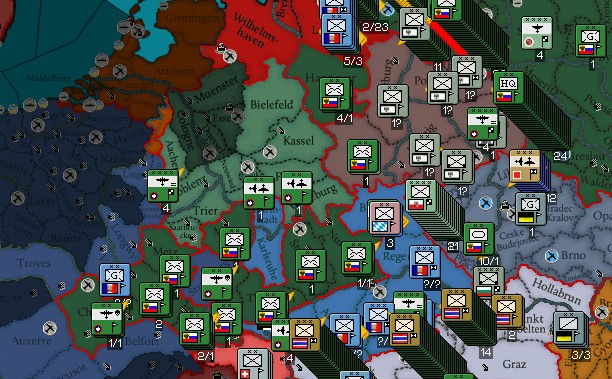
05:00: General offensive commences across the entire front. At critical points, Russian artillery concentrations rival that of the great war. The army tasked with defending the river crossing near Berlin is targeted by almost seven thousand guns and rocket projectors, including more than a thousand heavy pieces. There is approximately one Russian artillery piece for every three German defenders.
07:00: The Russian carrier fleet launches an attack on the regular Republican Navy North Sea Patrol force. The old battleship RNS Digger is sunk by B5Ns from Vladivostok along with a large number of escorts. The Russian carrier group runs for Copenhagen to avoid retribution by Republican aircraft and will remain there for the foreseeable future.
Russian bombers flying from Greece and the Levant launch a series of punishing attacks against the Republican Mediterranean fleet at Crete, sinking 3 second class battleships and an old battlecruiser, including RNS Leveller, Owen, Naseby, and Peterloo. This reduces Republican Naval Strength to its premier Carrier group, the Heavy Battleship fleet based in Florida, and the Home Fleet which has been defensively stationed on the West Coast of the Union of Britain.
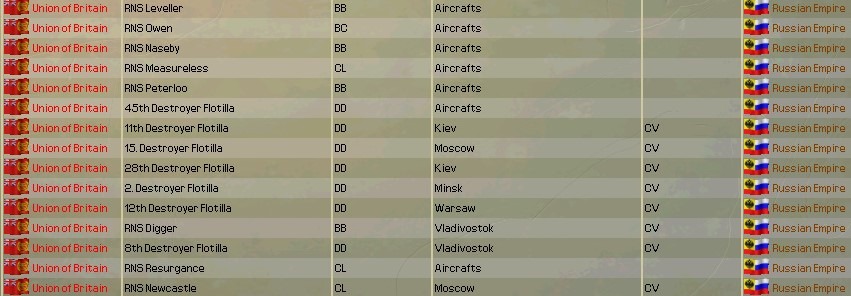
08:00: Unescorted Russian bombers attempt to strike the British Home Fleet at anchor. Poor weather and Republican defences prevent any ships being sunk while twenty one aircraft are shot down. With the element of surprise lost, further raids on the British isles are suspended. Russian intelligence does not identify the role of radar in repelling the raid.
09:00: 3rd Shock Army reports the first confirmed breakthrough of the offensive, shattering the lone Prussian division holding the frontier north of the Berlin Sector.
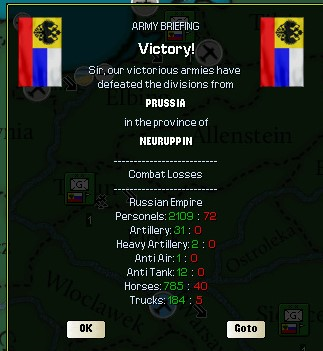
11:00 X Guards (Armenian) Division is the only airborne unit reporting ongoing resistance in its immediate drop zone at Erfurt. German red units of the 5th Red Division fight on despite dissent in the ranks, but the shock of the Russian assault and the presence of glider-borne light tanks creates confusion in the German Ranks. Identifying the threat and determined to complete the encirclement of Prussia on schedule, Malinovski gives the Armenians priority for ground attack sorties. 900 strike sorties will be launched in support of the unit before the Germans relent.

12:00: Combined Russo-Hungarian forces report a breakthrough at Landshut against combined Franco-Bavarian defenders. The infantry begin their advance towards their objective of Munich.

13:00: Reports that the Bulgarian army is making ground in Dresden are overshadowed by the critical breakthrough of the 2nd Shock Army at Augsburg. The battle is technically the first tank battle of the war as the 2nd shock army unexpectedly encounters two brigades of medium tanks supporting the defenders. Twenty seven are knocked out for the loss of two Russian vehicles. Reports of ‘shot proof’ Russian vehicles are dismissed as panic mongering. The breakthrough is vitally important as the 2nd Shock army will be able to link up with IX Guards (Finland) division by nightfall.
15:00: The Serbian army claims its first victory of the war, supporting the Russian breakthrough at Cottbus. Russian airpower begins tasking sorties not desperately required by airborne forces to victimise retreating enemy units.
16:00: Convinced that the element of surprise is fading, the Kaiser goes on Radio calling on all true Germans to rise up and support the liberation of Germany at the hands of German units and their Russian and Austrian allies. Russian airpower begins to victimise retreating German units, with Markov reasoning that ‘they have had their warning.’ Despite this assertion, rank confusion reigns in Paris, with Commanders lacking a coherent picture of the scale of the attacks.

20:00: 2nd Shock Army links up with IX Guards, opening supply lines to the airborne held corridor. 3 Reserve armies from the South German Front begin their train journeys to reinforce the airborne units across the Rhine
23:00: 4th Shock army takes 1,400 casualties but achieves its breakthrough at Revensburg. The Bulgarian motorised divisions perform well despite this blooding though local commanders note the need to improve cooperation between the Russian tanks and Bulgarian infantry in the coming days. German casualties are estimated as being four times higher, including many prisoners.
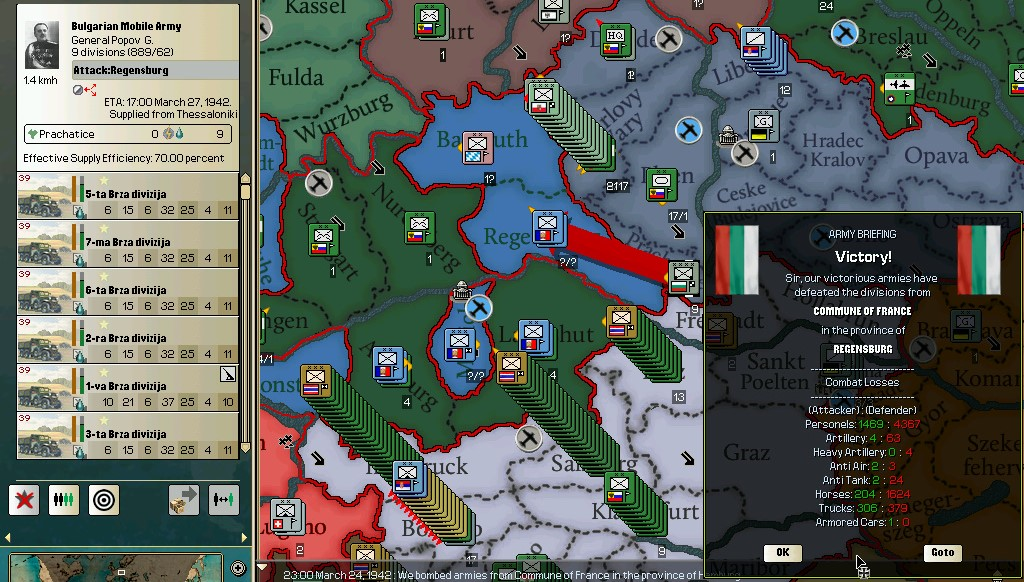
24:00. Trapped in a fallen capital, and with the secondary centre of Government of the Federation also in Russian hands, Bernhard Bästlein, the most avowedly anti-french of the German Syndicalist leaders, negotiates a surrender with Russian forces. 4,000 North Germans soldiers have been killed, wounded, or taken prisoner. At the announcement, another 21,000 raise white flags over their positions and wait for morning, leaving four French ‘friendship’ divisions attempting to conduct a night-time withdrawal through a now technically hostile country.
Foreword

From “Solar Dawn - The 1942 Imperial Offensives” by James Hetson
: The First Day
The Imperial Offensive that began on the 24th of March remains one of the most intensely studied military operations for all time, for understandable reasons. It pioneered a new style of warfare, was dramatic in its results, and was conducted on a scale rarely equalled in history.
As an operation, it was conceived with two key objectives in mind. The first was to rapidly secure Germany from the collaborationist Governments established by the Internationale. This goal was conceived for political as well as military reasons. The rapid liberation of Germany would limit damage to the German population and infrastructure and allow these to be more readily re-mobilised to support ongoing operations against the Commune and its allies. It was also believed that the political cooperation of the German citizenry, and attitudes in Austria, would be better influenced by a rapid campaign in Germany than an expensive slog.
The second objective was to avert a drawn out grind through the multiple fort lines holding both sides of the Rhine River. Following the defeat of Germany in 1940, the Commune had mothballed, but not destroyed in the German and French defences on the River, and Commune war planning provided for their reactivation in the event of war in Germany going badly. Russian planners anticipated that, more than any other factor, this defensive line and natural barrier might bog the campaign down and allow time for Internationale forces to be recalled from overseas. This last point is often forgotten in less thorough historiography which focuses on the ‘offensive spirit’ of Imperial leaders. In 1942 more than half of all Internationale divisions were stationed outside of Europe. Additionally, almost nine in ten new formations raised in 1941 had been raised outside of Europe (overwhelmingly in America which had exceeded the Union and Commune combined as early as 1941). A rapid campaign was not just desirable from a doctrinal perspective, it was a strategic necessity.
As planned by STAVKA and the allied powers at the Moscow conference, Operation Mercury leaned heavily on airborne, armoured, and rail-mobile units in order to achieve the planned speed and depth of penetration.
The French Commune was aware that Russia possessed an airborne deployment capability, and understood that this had been used in Manchuria. America and Britain had both been experimenting with airborne forces, though American experiments ended in 1936 and the British parachute unit, while a recognised elite, was still only Brigade Strength in 1942.
What the Internationale missed was both the possibility for strategically aggressive aggressive use of airborne units and the scale on which they could be employed. Germany had had a Falshirmjaeger division available in 1939 but this had ended up deployed on the frontline as an elite infantry formation, and the French were of the view that in any high intensity warfare environment, this or a limited tactical employment of parachute troops was the most that might be expected. French manpower and budget limitations prevented them indulging in any airborne experimentation of their own.
But In Russia, the airborne units had seized influence and power in the military establishment since their performance in the defence of Tula. The airborne units received heightened priority on equipment, received superior pay, and had their pick of regular army recruits. They also included a much higher density of Guards formations, with five of the army’s fourteen guards divisions being airborne formations. This largesse in prioritisation had even resulted in the development of hyper-specialised equipment, including large gliders and light, airborne tanks to accompany the infantry.

The Russo-Roman 1942 airborne offensive was thus conceived on a scale well beyond the imagination of Commune or military planners, and exploited the assumptions inherent in contemporary military thinking. The French could not conceive of a strategic airborne penetration on the imagined scale, and so made no efforts to defend against it.
Twelve divisions were deployed as the opening wave of the offensive. With the exception of two divisions tasked to help seize vital Government centres in the North German Federation and Prussia, the entire force was dedicated to a bold operation which intended to secure a corridor of intact bridges and rail lines from Southern Bavaria, across the Rhine, and into France. At its farthest extent, the I Guards division and its armour were dropped on the French fortifications at Chaumont, occupying them and seizing control of local infrastructure.
Given the nature of the Franco-German defence plan, the airborne landings encountered barely any resistance except for in Prussia, where a second line infantry formation of German Totalists was able to scramble to resist within a few hours of the landing. In France itself, the rigidity of the Commune’s war plan meant that even after news of the airborne landings began to reach Paris, first rate divisions continued to board trains for fronts in Germany, bound by their planning and the belief that mobilising second and third rate formations would be sufficient to crush what must be relatively small landings.
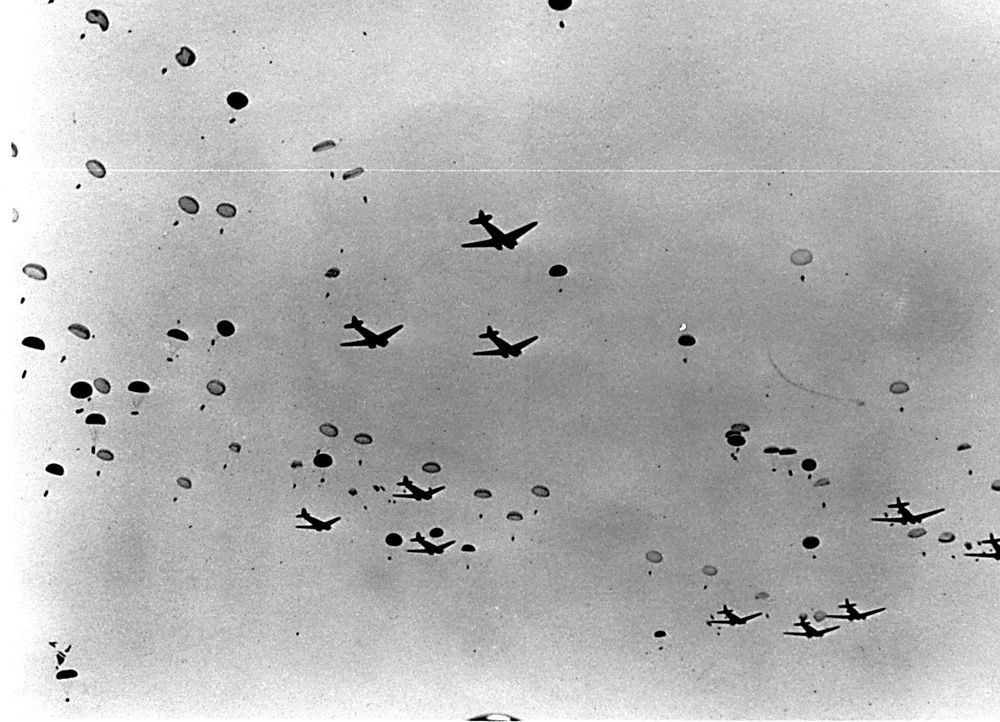
The airborne landings were primarily targeted at security vital transport infrastructure along a corridor that would link Austria with the airborne penetration across the Rhine into France.
On the first day of fighting, that link was won by the massed armoured and mechanized attack of the 2nd Shock army in Bavaria. As the tanks and half tracks of 2nd shock army advanced and the Cossacks mowed down retreating Bavarian and French troops, engineers embedded in the first assault waves inspected, repaired, and took control of rail and transportation infrastructure. By the end of the first day, the armour and airborne units had their first tenuous linkup in Bavaria, and three armies, staged in reserve, began their pre-planned rapid-redeployment deep into France.
As such, while great attention is paid to the storming of Berlin, the airdrops in the North German Federation, or the surrender of the Baestlein government only 19 hours after hostilities commenced, I would content it was actually the breakthrough by 2nd Shock Army, and the efforts of their engineers and the airborne engineers of the Guard and VDV that should be credited as the most decisive efforts of the first day. Had any of these units failed in their assigned tasks, the offensive timetable would likely have been gravely endangered.
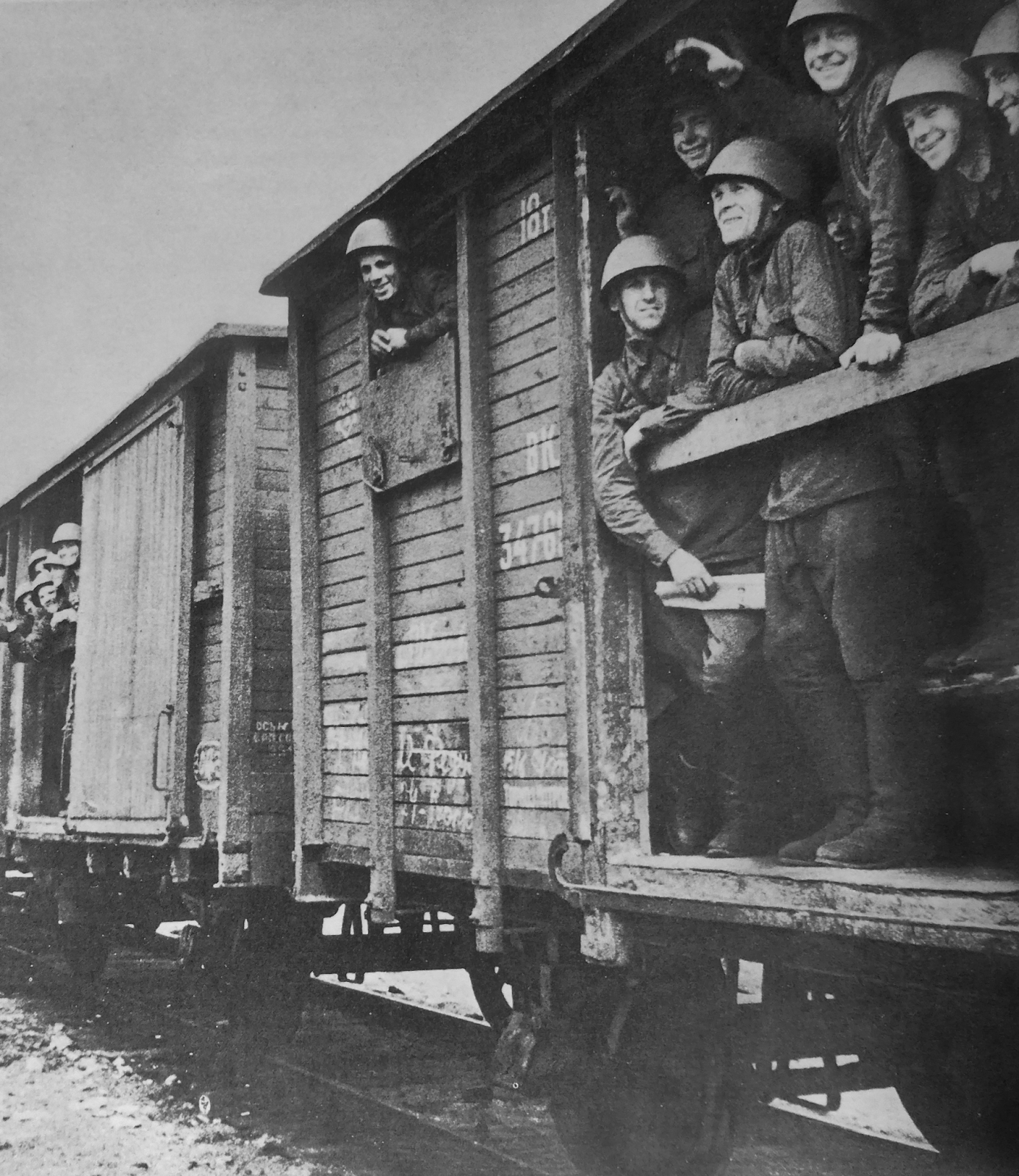
That being so, the offensives along the rest of the German frontier should not be denied their due, demonstrating as they did the new Russian way of war and the obsessions of the Russian staff.
Offensives opened with the saturation of enemy positions with artillery fire, followed by a combined infantry and heavy tank assault on the forward enemy positions. The attacks were intended to generate breakthroughs in the enemy tactical depths through which mobile forces could be poured into the operational and tactical depths of the enemy. While the number of heavy tanks attached to the breakthrough infantry was relatively small, the TH-40s that were deployed had an outsized impact on the shell-shocked defenders who found their anti-tank weapons mostly useless against the new Russo-Roman vehicles.
As the mobile units raced forward, fresh (as they had not been exhausted by the initial assault) they transitioned from reliance on infantry line-artillery to their own organic self-propelled and motorised guns while leading elements could call on air-support to make up short term deficits in local firepower. The combination of multiple breakthroughs and the insertion of extensive mobile forces into the enemy rear areas was then intended to generate confusion in the enemy command and supply system, and enable the trailing infantry units to ‘sweep’ the front forward and collapse pockets formed by the penetrating units.
In the opening day of Mercury, this theory was put into practice all along the front. Imperial artillery and rocket batteries saturated under-manned German positions with fire and then moved forward into trench and bunker lines. They created breaches through which the four Russian shock armies poured. By the end of the first Day, first and third shock armies had nearly encircled Berlin, second shock army had linked up with the airborne forces, and the mostly Bulgarian 4th shock army was racing towards Nuremberg.
These operations were supported by the actions of the German resistance and careful preparation for operations on German soil. Werewolf operations focused on causing confusion in enemy rear areas, targeting red commanders and officials in the cities, and helping to seize bridges or infrastructure in danger of destruction by the defenders. Meanwhile, Baltic Germans, Heer units, and German speaking Russians were embedded across the Imperial forces to enable communication with local Germans. While this would be more important in the following days, rather than during the initial breakthrough, it was an element of planning that would pay dividends later. Just as important were the use of German ‘guides,’ German exiles who were capable of providing local knowledge and insight to units moving through the German countryside.
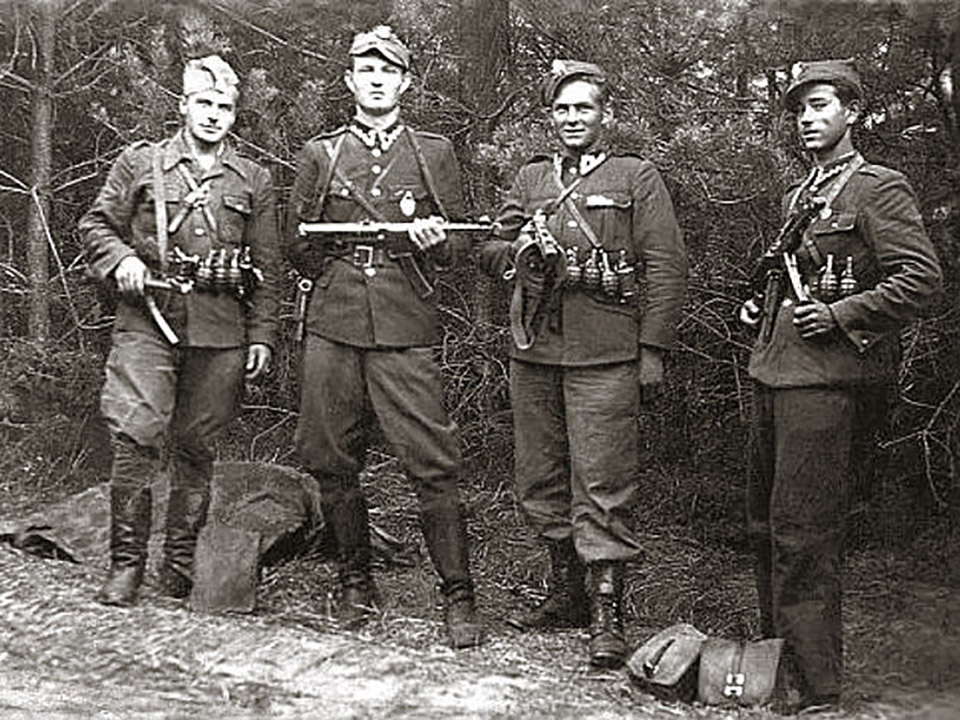
A ragtag group of German 'werewolves' By the time of operation Mercury, Vienna and Konigsberg exercised control over many of these bands
While the reaction of the Kaiser’s call to Germans to throw out the reds would not truly be felt until later in the operation as the news disseminated, the presence of German pathfinders and translators did ease the work of Imperial units that were moving into unfamiliar territory.
Russian air-operations on the first day of operations were generally subordinated to the airborne offensive, escorting the transports in and then providing intensive bomber support for units that faced resistance in their landing zones. As such, discussion of the aerial effort can be saved for consideration in later, more typical days of the operation. Suffice to say that the Imperial air forces launched 23,000 sorties on the first day of the operation, greatly enhancing the shock of the aerial offensive. At the contested landing of X Guards (Armenian) Division, approximately one ground attack sortie was launched for every ten German defenders. Germans joked that the Russians had a bomb for every man. They were not far from the truth.
Perhaps more significant, and often lost in the focus on the ground offensive, is the air-naval effort of the first day of war. The Russian carrier air group, never tested in battle, would launch their first combat operation in history, deploying a full strike package against the patrolling Republican North Sea Squadron before it had been made aware of the outbreak of war.
Faced with rough seas and accurate Republican anti-aircraft fire. The results of this strike were mixed. Torpedo bombers struggled to make their weapons count against the well manoeuvred Republican battleships, with only a single ship being sunk by the Russian license produced B5N torpedo bombers. The dive bomber units however claimed a bounty of Republican destroyers, and losses were comparatively light. The decision of the Russian commander to turn his fleet away and make for Copenhagen rather than launch a follow up strike has been criticised by some, but reflected a real and legitimate fear of Republican coastal aviation, even with carrier fighters as a defensive force. The Russian navy, having taken first blood, would proceed to hide in the Baltic for the rest of the opening offensive, leaving the Republican Home Fleet uncontested.

Greater casualties were inflicted on the Republican Mediterranean fleet at Crete, where a maximum effort strike by an entire air-army assailed the squadron in its port for hours and drew so much fire that many Cretan AA crews reported barrel deformation and warping. There the Republican Mediterranean squadron, considered the weakest of the Republican formations and a dumping ground for older designs, was more or less destroyed by the attack, though the location of the attack meant the vast majority of Republican sailors survived the loss of their ships.
A final raid was attempted using unescorted bombers, flying from Scandinavia, against the Republican Home Fleet base on the West coast of the British Isles. There, the Russians received a bloody nose from radar guided alert fighters and extensive AA emplacements. Damage to naval installations was minimal, and losses heavy. This experience, coupled with the destruction of Republican targets in the Mediterranean and the sheltering of the Baltic fleet, meant that Russia and its allies would refrain from any further anti-shipping operations for some time. Caution was the order of the day when dealing with Britain and her fleet now that surprise was exhausted.
Taken together, as the first day of Mercury closed, the Imperial forces could breathe a sigh of relief. They had achieved the required breakthroughs, the North German Federation, always bitter towards the Commune, had thrown its hands up in apathetic surrender, and the risky airborne operations had all seized their initial objectives. The British still ruled the waves, but the margin between the red and Imperial fleets had been reduced somewhat.
The following days would now hinge on the ability of the Imperial Mechanised forces to exploit the breakthroughs, and the ability of the airborne forces to resist counter-attacks until support arrived.
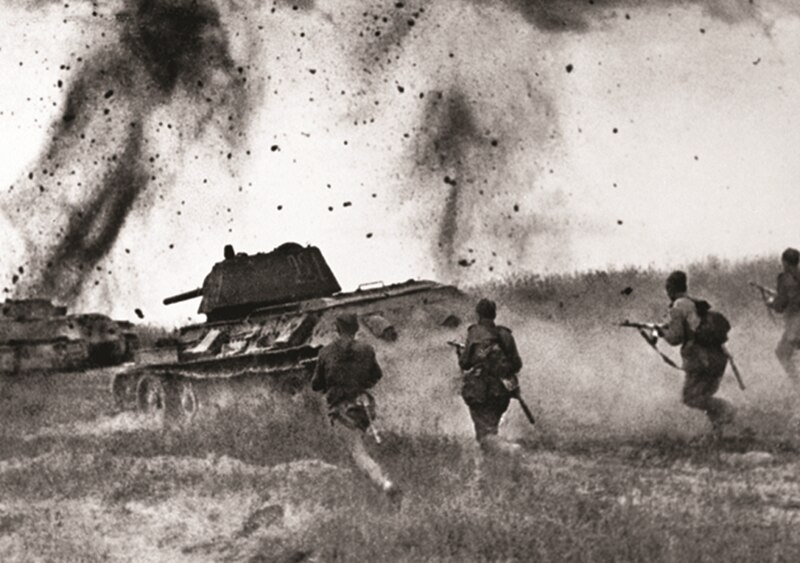
Can't say I am surprised about the mixed results from naval operations, though at least the Med is now a more equal playing field. What is the damage like to the RNS? Even if they weren't destroyed, damaged carriers will probably take a few months to repair in port taking them out of the immediate equation. It is a good thing Scandinavia and the German Baltic coast is under our control, else, the Baltic even as far as Petrograd would not be safe for our ships.
Damn, did not expect Chalons to be one of the targets. I guess it's all the better for when we come rolling in.
In hindsight I understand it; its the key to the French interior after the fortress network, get the armoured divisions there and they will be able to strike at the French at will. Envelopments of armies, seizing of VP's, taking Paris, etc; its all possible once you take that province.Damn, did not expect Chalons to be one of the targets. I guess it's all the better for when we come rolling in.
It also doubles as a bit of territorial depth for the paratroopers to retreat from should they be pressed before help arrives; so long as the forts are held, the French will have no defensive parameter. It's even enough that they took these provinces since it takes time to repair the forts.
French manpower must be non-existent on account of their war with Germany, African commitments, and huge land army. Those forts would have let them trade concrete for blood, with them gone, it will be all blood and in that contest Russian victory is inevitable.
And suddenly, Mosley is looking at this news and the Russian Navy use of aircraft carriers and might just be wondering about how impregnable Britain will prove.But In Russia, the airborne units had seized influence and power in the military establishment since their performance in the defence of Tula. The airborne units received heightened priority on equipment, received superior pay, and had their pick of regular army recruits. They also included a much higher density of Guards formations, with five of the army’s fourteen guards divisions being airborne units. This largesse in prioritisation had even resulted in the development of hyper-specialised equipment, including large gliders and light, airborne tanks to accompany the infantry.

